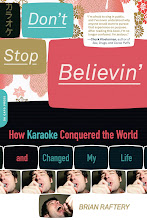
The karaoke video should have died years ago. In the early-to-mid-'90s, U.S. manufacturers realized they could cut down costs by switching from lavishly produced Laserdiscs to the relatively cheaper CD+G (compact disc + graphics) format. CD+Gs had long been popular in Asia, and it's easy to understand why: Not only could they hold far more songs than Laserdiscs, but they were also much easier to carry around, meaning that millions of sing-along enthusiasts could now croon in the privacy of their own homes or grotto. Karaoke jockeys, meanwhile, no longer had to haul around back-breaking crates of music just to play a gig.
There was an aesthetic downside to this cost-efficient technology, however, one that became obvious before the song made it to the first chorus. Whereas the karaoke videos (or “karaokes”) of the '80s featured elaborately staged, often absurd live-action shorts, the CD+G discs usually consisted of abruptly unfolding lyrics and some garish color patterns; occasionally, producers inserted a random "cool" visual halfway through, though many of them look like bad Nagel-painting knock-offs. The Japanese had intended for karaoke videos to boost the singer's confidence, theorizing that if audience members were distracted by the strange on-screen clips, then the singer's nerves would be calmed. Now those impossible-to-avoid images were gone, replaced with graphics that could have been created on an Apple IIc. Within just a few short years, an entire small-scale art form was nearly wiped out.
Then came YouTube. At first, the site’s karaoke-video options were limited to brief snippets of some presumably drunken subject singing a few lines from “Ballroom Blitz,” and then quickly throwing his or her hands up in shame. But as of summer 2007, there are thousands of clips that could be considered as karaoke videos: Spur-of-the-moment sing-alongs, educational guides, demo tapes—you can even find vintage clips from the '80s and '90s. Technology once rendered the karaoke-video art form obsolete; now, thanks to enthusiastic YouTubers, it's been revitalized and archived.
To illustrate the evolution of the karaoke, I spent an afternoon watching dozens of clips that resulted from the search terms "karaoke hotel california" (the track has always been a popular sing-along number, despite the fact that the second half of the song is essentially a drawn-out dueling-guitar solo). After about an hour or so, my head grew heavy and my sight grew dim—but not before I could catalog the four types of karaoke videos that most commonly populate the site:
The “Official” Clip
A professional-looking video, though not an especially good-looking one. The model looks bored—as do the boats—and while there is a shot of a hotel at one point, it seems like it’s situated in Florida, not California. Commercially produced karaokes such as this one have only recently begun to pop up on YouTube, and I’m guessing that’s partly because of copyright protection, and partly because so few people have access to the “classic” Laserdiscs collections that went off the market more than a decade ago.
The Demo Tape
The clip may not look too slick, but rest assured: In the hours before it was uploaded, the camera angle was rejiggered multiple times, the CD player was placed next to the speakers at a precise angle, and an unseen friend was implored to hit the “record” button at a planned time. There are thousands of karaoke audition reels like this on YouTube, though it’s not always clear what sort of reward the singers want: A label deal? Some positive comments? A vote in some vaguely disclosed talent show?
The Viewer-as-Voyeur
Thanks to herky-jerky camerawork and low-quality fidelity, these caught-in-the-act videos are often difficult to watch, especially for a whole five minutes or so. But more than any other form of karaoke video, they capture what it’s like to spontaneously sing in public—the fear, the awkwardness, and the inevitable moment when self-consciousness gives way to joy. That said, sometimes they’re best viewed with the sound off.
The Cheatbook
The vocals are buried way down on the bottom, and the on-screen lettering is big and blurry, in a style reminiscent of those “Take Me Drunk I’m Home” shirts that you could get at Spencer’s Gifts in the ‘90s. There’s no storyline here, no stock footage, and—in this case, at least—no color; it’s the sort of follow-the-word clip that exists solely for those playing along at home. A good teaching aide, but not much fun otherwise.

No comments:
Post a Comment